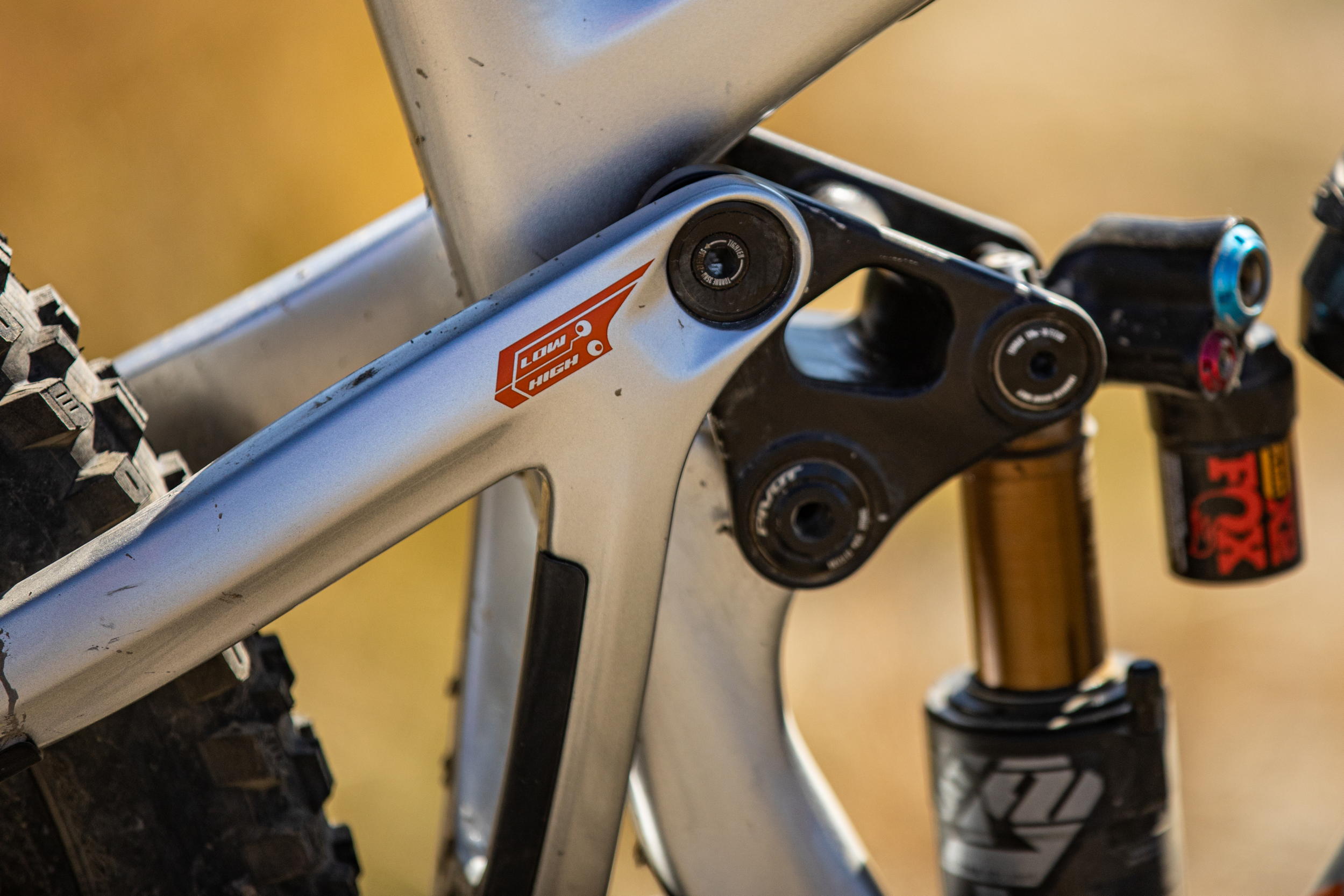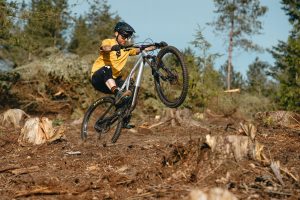12-months aboard the Pivot Firebird Pro enduro bike and James can't bear to part with it. So he bought it...
I tested the Pivot Firebird Pro for 12-months and loved it so much I bought one
Most riders like to begin a relationship with a new bike on local trails, taking the time to ease into things while feeling out the lay of the land. Not me. The Firebird and I started our time together with what can only be described as a baptism by fire. I picked up the bike from Saddleback HQ on a Thursday and drove straight to the Alps the following day.

Pivot’s Firebird Pro is one seriously hot enduro bike!
Pivot Firebird Pro XT/XTR need to know
- 29er enduro race bike with 165mm travel at the rear married to a 170mm fork
- Four frame sizes, all with proportional chainstay lengths: 430mm, 433mm, 437mm and 444mm
- Flip chip and an angleset friendly 1.5in headtube offer lots of adjustability, including MX wheel compatibility
- Ready to race EWS Pro spec with Fox Factory suspension, alloy DT Swiss wheels and Maxxis EXO+ Assegai tyres
This in-at-the-deep-end approach really opened my eyes to just how defined and refined the Firebird’s capabilities are. But before I get to those, let’s take a closer look at the bike. The Firebird platform is designed around being fast, capable and efficient; all desirable characteristics in any contender looking to compete with the best enduro race bikes. Like all of Pivot’s full suspension bikes, it runs a DW-Link design, albeit a version that features longer links and a change of pivot position that’s shared with the Phoenix DH bike. Previous experience has led me to really rate this design for its ability to provide an efficient pedalling platform without too much compromise to suspension performance – I’m hoping the Firebird will only back-up that opinion.

DW-Link suspension impressed James with its ability to climb as well as devour alpine descents
On the latest version of the Firebird, travel has been upped from 162mm on the previous version to 165mm. Geometry is designed around a 170mm fork (although you could fit a 180mm if you wanted). The biggest change, other than the increase in reach and size specific chainstay lengths, is the shock position. It now features a vertical shock orientation that opens up the front triangle for a full size water bottle. The shock is trunnion mounted, and as per the previous version the design is rated for both air and coil shocks.

Pivot’s Firebird Pro gets well-resolved internal cable routing
What attracted you to the Pivot?
I’ve long been a fan of the brand, ever since owning and racing a Pivot Les (hardtail) way back in 2011. Despite going through a phase where its frames were a shade on the ugly side, the new crop of models are some of the most well-proportioned and beautiful bikes on the market. I’m also a DW-Link aficionado, as I love pedalling up hills, and the Firebird looked to offer a great mix of long-travel fun and all-day pedalling efficiency.

165mm of rear wheel travel on the Firebird. Note the drain hole at the base of the down tube
Did you change anything straightaway?
The day after I picked up the Firebird I went straight to the Alps for two weeks, so I didn’t have time to change anything. I had to just go with the chef’s choice of the standard spec. Luckily for me, every component of the bike work without any faults or niggles – even very personal items such as the saddle and grips.

Flip chip gives two geometry settings (James left it in ‘low’), and the Climb Switch on the Float X2 shock is in easy reach
Is the bike easy to set up?
Very. Pivot provides simple setup instructions for the Fox Float X2 shock. The baseline settings felt really good from the off and the idiot-proof sag measurement technique (line the o-ring up with the end of the piggy back reservoir) is genius level. I kept the geometry flip chip in the low setting for the majority of the year and following the setup table found on the back of the Fox 38 fork also produced very usable results.

The Firebird Pro is a sharp bike that raised James’s game, from the Alps to South Wales
How does it ride?
The Pivot Firebird Pro is the fastest bike I have ever ridden. After ten days of roots, rocks and braking bumps in Morzine, multiple days at BikePark Wales, and my bread and butter of the steep enduro tracks of South Wales, I can safely say the Pivot has elevated my riding to a new level. I’ve broken Strava PRs left, right, and centre on this bike. And it’s gotten under my skin to the point where I couldn’t let it go back to Saddleback. I had to buy it. Yes, I put my hand in my pocket and now own this bike. Which is something I’ve never done.

James was regularly blown away by the grip from the DW-Link suspension
The level of grip from the DW-Link suspension regularly blew me away; I could honestly push as hard into corners as my confidence levels would let me. Even better, and a sign as to how special the Firebird is, it rarely felt like I was riding anywhere near my limit. So I know there’s more speed to be gained.
I’ve really appreciated the 4-way adjustable suspension, too. Actually it’s more like six-way, when you factor in air pressure and air volume. Which can seem overwhelming at first, but jot down your baseline settings (Pivot provides these) and you always know you can find your way back if you get lost in the clicks.

Even back home James racked up numerous Strava PRs on the Firebird Pro
It’s also a really capable bike uphill. That DW-Link working black magic on the Firebird’s pedal efficiency. The price you pay for that climbing ability is a reduction in sensitivity of the rear suspension at the start of the stroke. And on certain trails, especially at lower speeds, the rear end transmits more feedback than other similar travel bikes I’ve ridden. But the Firebird is a race bike, it’s meant to be ridden hard and pedalled even harder so I’m happy to trade these traits for a bike that responds so well to out of the saddle efforts.

For such a capable descender, the Pivot was equally rapid uphill
Accordingly, the Firebird also has one of the most laterally stiff rear ends I’ve ridden, which is great for unintended sideways landings, but the trade-off is that traction on slippery off camber roots and rocks isn’t quite as good as on a bike with more flex. It also means the rear wheel saw a lot of spoke key action during my 12 months on the bike.

WTB saddle didn’t stay box-fresh for long
Did anything break or wear out?
The two parts of the spec I’ve had issues with have been the Shimano XT brakes and the WTB saddle. The brakes have needed way more TLC than any other set of brakes I currently have (including other XT brakes). I’ve had to do a full bleed at least twice in the last year due to a wandering bite point and spongy lever action. The first WTB saddle split after a couple of months of use, and its replacement is now creaking so badly that I’m embarrassed to sit down when riding with company.

Pressfit bottom bracket remained trouble-free all year
If you could change one thing about the Pivot Firebird Pro what would it be?
There’s no getting away from the fact that the Super Boost 157mm rear end leaves you with a few compatibility issues that might limit component choice down the line. Yes, I’m sure it does create a stronger rear wheel (mine has held up admirably) but not every brand produces parts, so I’d prefer it if the frame had standard 148mm boost hub spacing.

A happy customer! James with, what’s now, his own Firebird Pro
Would you buy this bike?
I did! Even looking past the ride quality and sheer capability of the frame and component list, it’s the long-term stuff I really rate. The build quality of the carbon frame is super clean, the cable routing is exactly how you want it, and even after a year, all the frame bearings are as-new. Also, and this is probably the best point, this is the first frame with a press-fit bottom bracket that has not uttered a single noise. Dreamy.
Verdict
It’s too easy to use the term ‘confidence inspiring’ when a bike has 170/165mm of travel front and rear. But the Firebird is hands down the one bike that has improved my riding beyond all others in recent memory. The reach, when combined with the 50mm stem, make the size large fit me like a custom frame. To use another cliche: I feel at home on this bike. It’s also what I would classify as a true enduro bike. One that is a joy to pedal up the hills as much as it is to descend.
















